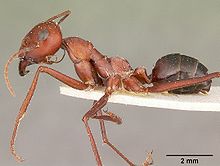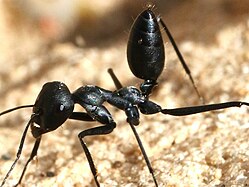Cataglyphis
| Cataglyphis | |
|---|---|

| |
Cataglyphis bicolor worker
| |
| Scientific classification | |
| Domain: | Eukaryota |
| Kingdom: | Animalia |
| Phylum: | Arthropoda |
| Class: | Insecta |
| Order: | Hymenoptera |
| Family: | Formicidae |
| Subfamily: | Formicinae |
| Tribe: | Formicini |
| Genus: | Cataglyphis Förster, 1850 |
| Diversity[1] | |
| 93 species | |
| Synonyms | |
|
Eomonocombus Arnol'di, 1968 | |
Cataglyphis [2] is a genus of ant, desert ants, in the subfamily Formicinae. Its most famous species is C. bicolor, the Sahara Desert ant, which runs on hot sand to find insects that died of heat exhaustion, and can, like other several other Cataglyphis species, sustain body temperatures up to 50°C.[3] Cataglyphis is also the name of an autonomous rover[4] that won the NASA Sample Return Robot Centennial Challenge[5] inspired by the navigation approaches used by desert ants.
Name
It was named in 1850, with reference to the impressions of its abdomen: "Von χατά und γλυψίς der Einschnitt. Eine Andeutung auf die vielen Einschnitte oder vielmehr Eindrücke de Hinterleibs."[6]
Description
Species of this genus are behaviourally, morphologically, and physiologically adapted to dry and hot habitats.[7]
In the Sahara, ants live where no bushes or clumps of grass are available to protect them, and where tracks are covered by wind-blown sand in seconds. The midday sun is so hot that even the permanent residents, sand lizards, insects, and a few birds, have to take shelter, but this is when, for not much more than an hour, Cataglyphis spp. are to come out of their underground nests and forage. They can withstand higher temperatures than any other insects.[citation needed] They pour out on to the sand and search for insects that have died of heat stress. Each ant dashes about in zigzag patterns, but as soon as one is lucky enough to find a tiny insect corpse, it has to get it back to the nest fast before the ant dies of the heat. It does not retrace the zig-zagging path of its outward journey; even if a scent trail made this possible, such a route would be time-wasting. Instead, it runs in a straight line directly back to its nest hole.[8]
On its outward journey, it zig-zags right and left. Every time it changes direction, it lifts its head and wheels around to take a bearing on the sun. In addition, it has to remember how far it went on each straight run. When time to head for home, it has to sum all these data and come out with the precise direction needed. Some outward journeys take an ant a quarter of an hour, with sun sightings every few seconds.[8]
In an experiment, individual ants were fitted with an apparatus that blocked direct sight of the sun, while giving a false impression of where the sun was, using a mirror. When these ants headed for home, they dashed off to a point in the desert displaced by just the amount that the mirror had shifted the sun's position.[8]
Like ants in the
-
C. nigra with raised gaster
Distribution
At least five different species of Cataglyphis occur in the
Parthenogenesis
Queen ants of the species C. cursor can produce female reproductive progeny (i.e. potential new queens or gynes) by parthenogenesis.[14][15] Parthenogenesis, in this case, involves, a process (automictic thelytoky) by which two haploid products of meiosis fuse to form a diploid zygote that develops into a gyne. Queens can also produce female worker ants by sexual reproduction involving fertilisation of eggs.
Species
- Cataglyphis abyssinica (Forel, 1904)
- Cataglyphis acutinodis Collingwood & Agosti, 1996
- Cataglyphis adenensis (Forel, 1904)
- Cataglyphis aenescens (Nylander, 1849)
- Cataglyphis agostii Sharaf, 2007
- Cataglyphis albicans (Roger, 1859)
- Cataglyphis alibabae Pisarski, 1965
- Cataglyphis altisquamis (André, 1881)
- Cataglyphis arenaria Finzi, 1940
- Cataglyphis argentata (Radoszkowsky, 1876)
- Cataglyphis asiriensis Collingwood, 1985
- Cataglyphis aurata Menozzi, 1932
- Cataglyphis bellicosa (Karavaiev, 1924)
- Cataglyphis bergiana Arnol'di, 1964
- Cataglyphis bicolor(Fabricius, 1793) — Sahara Desert ant
- Cataglyphis bicoloripes Walker, 1871
- Cataglyphis bombycina(Roger, 1859) — Saharan silver ant
- Cataglyphis bucharica Emery, 1925
- Cataglyphis cana Santschi, 1925
- Cataglyphis cinnamomea (Karavaiev, 1910)
- Cataglyphis cugiai Menozzi, 1939
- Cataglyphis cuneinodis Arnol'di, 1964
- Cataglyphis cursor (Fonscolombe, 1846)
- Cataglyphis diehlii (Forel, 1902)
- Cataglyphis douwesi De Haro & Collingwood, 2000
- Cataglyphis elegantissima Arnol'di, 1968
- Cataglyphis emeryi (Karavaiev, 1911)
- Cataglyphis emmae (Forel, 1909)
- Cataglyphis espadaleri Cagniant, 2009
- Cataglyphis flavitibia Chang & He, 2002
- Cataglyphis flavobrunnea Collingwood & Agosti, 1996
- Cataglyphis floricola Tinaut, 1993
- Cataglyphis foreli (Ruzsky, 1903)
- Cataglyphis fortis (Forel, 1902) — Sahara desert
- Cataglyphis fossilis Cagniant, 2009
- Cataglyphis frigida (André, 1881)
- Cataglyphis gadeai De Haro & Collingwood, 2003
- Cataglyphis gaetula Santschi, 1929
- Cataglyphis glabilabia Chang & He, 2002
- Cataglyphis gracilens Santschi, 1929
- Cataglyphis hannae Agosti, 1994 — Tunisia
- Cataglyphis harteni Collingwood & Agosti, 1996
- Cataglyphis helanensis Chang & He, 2002
- Cataglyphis holgerseni Collingwood & Agosti, 1996
- Cataglyphis humeya Tinaut, 1991
- Cataglyphis iberica (Emery, 1906)
- Cataglyphis indica Pisarski, 1962
- Cataglyphis isis (Forel, 1913)
- Cataglyphis israelensis Ionescu & Eyer, 2016
- Cataglyphis italica (Emery, 1906)
- Cataglyphis karakalensis Arnol'di, 1964
- Cataglyphis kurdistanica Pisarski, 1965
- Cataglyphis laevior Santschi, 1929
- Cataglyphis laylae Collingwood, 2011
- Cataglyphis livida (André, 1881)
- Cataglyphis longipedem (Eichwald, 1841)
- Cataglyphis lunatica Baroni Urbani, 1969
- Cataglyphis machmal Radchenko & Arakelian, 1991
- Cataglyphis marroui Cagniant, 2009
- Cataglyphis mauritanica (Emery, 1906)
- Cataglyphis minima Collingwood, 1985
- Cataglyphis nigra (André, 1881)
- Cataglyphis nigripes Arnol'di, 1964
- Cataglyphis nodus (Brullé, 1833) — Dalmatia
- Cataglyphis oasium Menozzi, 1932
- Cataglyphis opacior Collingwood & Agosti, 1996
- Cataglyphis otini Santschi, 1929
- Cataglyphis oxiana Arnol'di, 1964
- Cataglyphis pallida Mayr, 1877
- Cataglyphis piligera Arnol'di, 1964
- Cataglyphis piliscapa (Forel, 1901)
- Cataglyphis pilisquamis Santschi, 1929
- Cataglyphis pubescens Radchenko & Paknia, 2010
- Cataglyphis rosenhaueri Santschi, 1925
- Cataglyphis rubra (Forel, 1903)
- Cataglyphis sabulosa Kugler, 1981
- Cataglyphis saharae Santschi, 1929
- Cataglyphis savignyi (Dufour, 1862) — Sahara desert
- Cataglyphis semitonsa Santschi, 1929
- Cataglyphis setipes (Forel, 1894)
- Cataglyphis shuaibensis Collingwood & Agosti, 1996
- Cataglyphis stigmata Radchenko & Paknia, 2010
- Cataglyphis tartessica Amor & Ortega, 2014
- Cataglyphis takyrica Dlussky, Soyunov & Zabelin, 1990
- Cataglyphis theryi Santschi, 1921
- Cataglyphis urens Collingwood, 1985
- Cataglyphis vaucheri (Emery, 1906)
- Cataglyphis velox Santschi, 1929
- Cataglyphis viatica (Fabricius, 1787)
- Cataglyphis viaticoides (André, 1881)
- Cataglyphis zakharovi Radchenko, 1997
References
- ^ Bolton, B. (2014). "Cataglyphis". AntCat. Retrieved 17 August 2014.
- PMID 19250516.
- S2CID 206638368.
- ^ "NASA_Challenge". www2.statler.wvu.edu. Archived from the original on 2016-07-02. Retrieved 2016-09-29.
- ^ Hall, Loura (2016-09-08). "NASA Awards $750K in Sample Return Robot Challenge". Retrieved 2016-09-29.
- ^ Foerster, A. 1850b. Eine Centurie neuer Hymenopteren. Zweite Dekade. Verh. Naturhist. Ver. Preuss. Rheinl. Westfal. 7: 485-500 (page 493)
- ^ a b Petrov, I.Z. (1986). "Distribution of species of the genus Cataglyphis Foerster, 1850 (Formicidae, Hymenoptera) in Yugoslavia" (PDF). Arhiv Bioloskih Nauka. 38: 11–12.
- ^ ISBN 0-316-05751-7.
- PMID 22178639. Retrieved 2023-05-12.
- ^ Bernard, F. (1968): Les fourmis (Hymenoptera: Formicidae) d'Europe occidentale et septentrionale.
- .
- .
- ^ Borowiec, L.; Salata, S. (2013). "Ants of Greece – additions and corrections (Hymenoptera: Formicidae)" (PDF). Genus. 24 (3–4). Wroclaw: 335–401.
- S2CID 37558595.
- PMID 21307046.
Further reading
- Heusser, Daniel & Wehner, Rüdiger (2002): The visual centring response in desert ants, Cataglyphis fortis. The Journal of Experimental Biology 205: 585-590. Full HTML - PDF
External links
 Media related to Cataglyphis at Wikimedia Commons
Media related to Cataglyphis at Wikimedia Commons- YouTube: Video of Cataglyphis catching prey in the Sahara desert

